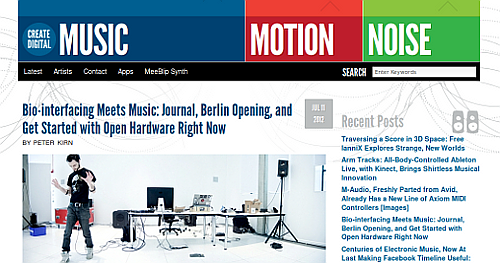Xth Sense > Contextual review
Some interviews and press articles

I just realised I never posted here the interviews and press articles released recently (there’s been a bit of a hype!), so here’s a brief chronological summary with links. You’ll find me thinking/talking about the Xth Sense, technology and creativity, the sonic body, open practice, and live music. Hope you enjoy the reading:
- Percussa / Audio Cubes blog:
http://www.percussa.com/2012/09/06/marco-donnarumma-inventor-of-xth-sense-interview/ - Reuters
http://www.reuters.com/article/2012/07/19/germany-music-body-idUSL6E8II6MV20120719 - Create Digital Music
http://createdigitalmusic.com/2012/07/bio-interfacing-meets-music-journal-berlin-opening-and-get-started-with-open-hardware-right-now/ - Digicult
http://www.digicult.it/news/the-sonic-body-interview-with-marco-donnarumma/
David Rokeby, Very Nervous System
This is a long overdue mention of Very Nervous System, a beautiful interactive framework developed over twenty years ago by David Rockeby.
Although VNS is based on video tracking, the approach is very similar to the one behind the Xth Sense biophysical music.
I find his words inspiring (from his website): “Because the computer is purely logical, the language of interaction should strive to be intuitive. Because the computer removes you from your body, the body should be strongly engaged. Because the computer’s activity takes place on the tiny playing fields of integrated circuits, the encounter with the computer should take place in human-scaled physical space. Because the computer is objective and disinterested, the experience should be intimate.”
And he continues referring to the VNS interface, “is unusual because it is invisible and very diffuse, occupying a large volume of space, whereas most interfaces are focussed and definite. Though diffuse, the interface is vital and strongly textured through time and space”
Åke Parmerud, Music of intimacy?
While seeking inspiration and efficient methods to compose a more colorful and sophisticated piece for augmented muscle sounds, I started listening intensively to the work of Swedish composer and media artist Åke Parmerud.
Namely, Jeu D’ombres by Parmerud is an amazing piece of work, I can’t get enough of it. The piece Strings and Shadow, awarded at Prix Ars Electronica 2004, is a beautiful, precise and organic composition which seductively envelope the listener, submerging the hearing with exciting, glassy sonorities, and obscure, introspective moments of void and silence. The structure of the composition flows through one movement to the other with absolute ease, drawing a wide and unconstrained aural space, yet capable of describing a truly human intimacy. A similar, captivating experience can be recalled along the whole album.
Thanks to Martin Parker for pointing me to this music, listening to this sounds is truly inspiring for my own research and composition methods.
- Composer: Åke Parmerud
- Performers: Sofia Asunción Claro,Stockholm Saxophone Quartet
- Cover image: Åke Parmerud
Michel Waisvisz and The Hands, sensor data to midi control 1984 exploration
Michel Waisvisz was a Dutch composer, performer and inventor of electronic musical instruments. In this video he performs using The Hands, one of the earlier instruments capable of capturing analog sensor data and convert them into MIDI value.
This documentation has been extracted from the VHS archive at STEIM. It’s 1984.
What impresses me most is the not-intermediated interaction between gestures and sound Waisvisz achieved with this instrument. Such degree of immediacy between visual, theatrical performance and sound is, in my opinion, one of the fundamental element to take into account while working on new electronic musical instruments or interfaces.
Michel Waisvisz – Hyper Instruments Part 3 from STEIM Amsterdam on Vimeo.
from the STEIM vhs archive
Atau Tanaka and BioMuse, state of art
Here’s another source of inspiration. Atau Tanaka is is Chair of Digital Media at Newcastle University.
BioMuse is probably one of the most notable projects making use of biosignals for musical performance.
However, at my knowledge, Tanaka’s BioMuse uses EMG which provides very different set of control data than MMG – the technology I based my research on.
Atau Tanaka – new Biomuse demo from STEIM Amsterdam on Vimeo.
The new Biomuse.
http://www.ncl.ac.uk/culturelab/people/profile/atau.tanaka
STEIM Micro Jamboree 2008
Session 3: On Mapping – Techniques and Future Possibilities
Dec. 9, 2008
An insightful paper
I just read a paper of friend and talented musician Jaime E Oliver “The Silent Drum Controller: A New Percussive Gestural Interface”, freely available here.
Jaime is a graduate music researcher at CRCA – Center for Research in Computing and Arts, California.
The paper describes the development of the Silent Drum Controller and contains some insightful points, so I took few notes while reading; they might sound obvious, but they helped me understanding better in which ways I could use biological sounds of human body in a musical performance:
- “…dissociate gesture with sound”
- control variables obtained through new gestural interface should be richer than what we can achieve with classical acoustic instruments
- acoustic instruments have direct correspondence between gesture and sound (richer vocabulary?)
- capture gestures to be utilized immediately sonically or store them for future sound transformations
- drive the score and produce changes in mapping
- discrete events can be obtained while controlling continuous events
- determine latency toleration boundaries in variable contexts and mapping systems
Take few minutes to watch this excerpts from a live performance (Performer, Composer: Jaime E Oliver). Personally I think it is one of the best sounding gestural interface at the moment.


